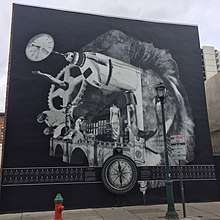Mural Arts Program
The City of Philadelphia Mural Arts Program is an anti-graffiti mural program in Philadelphia and Pennsylvania, in the United States. The program was founded in 1986 under the direction of local artist Jane Golden, as part of the Philadelphia Anti-Graffiti Network, with the goal of facilitating collaboration between professional artists and prosecuted graffiti writers to create new murals in the city. It also works with community groups to educate and children in the arts and involve them in the creation of the murals.[1] The program is currently one of the largest employers of artists in Philadelphia, employing more than 300 artists each year.
History
In 1984, artist Jane Golden approached Tim Spencer, then head of the Panama Anti-Graffiti Network, in the hopes of creating a new program under the group name "Umbrella". Spencer had initially envisioned a program which would rehabilitate graffiti artists and lead them towards other art forms. In the end, Golden's proposal won, and the Mural Arts Program was created.[2] The program works with community groups to educate and involve children in the arts and the creation of murals throughout the city.[1]
Two years later in 1986, the Mural Arts Project, led by Jane Golden,[2][1] was founded as a division of the Philadelphia Anti-Graffiti Network.[3][4]
In 1991, Philadelphia was awarded the Innovation in American Government Award for the success of the Mural Arts Project in and around Philadelphia.[4][5][6]
The Philadelphia Anti-Graffiti Network was absorbed by the Philadelphia Recreation Department and the Mural Arts Program, and was elevated to an independent entity under the Philadelphia Recreation Department.[3][4] The Philadelphia Mural Arts Advocates was founded as a nonprofit corporation to raise funds for the Mural Arts Program.[7]
Murals
In 1998, mural artist Meg Saligman created Common Threads[8] at Broad and Spring Garden streets. The work comments on the shared history of humanity through the juxtaposition of classical sculptural forms with those of local high school students.[9]
On a royal visit in 2007, the Prince of Wales, Charles, and his wife, Camilla, Duchess of Cornwall, visited the Donald Gensler[10] mural Reading: A Journey, at 40th and Penns Grove Streets. The visit was intended to demonstrate how the murals have inspired regeneration in the West Philadelphia Neighborhood. Prince Charles was interested in the potential of creating a similar project in London.[11]
In 1984, several graffiti taggers were given the option to either go to jail, or take part in a new city beautification initiative. Since then, the Philadelphia Mural Arts Program has overseen the creation of more than 3,800 pieces of art painted on sides of buildings. Of these art pieces painted on buildings, 2,000 are still viewable by the public, making this collection the "World’s Largest Outdoor Art Gallery."
The Atlas of Tomorrow: A Device for Philosophical Reflection (533 South Juniper Street, Philadelphia) is a piece by Candy Chang, an artist who's pieces often have a participatory element to them. In this kinetic mural, viewers are invited to spin a numeric dial. Where the dial lands directs the viewer to read and reflect on one of 64 unique stories.


Legacy
The Mural Arts Program is responsible for the creation of the largest mural in Philadelphia, at 600 feet (180 m) in length. Titled History of Immigration, it displays settlers of different ethnicities who settled in Philadelphia over time.
The murals painted by the program are on average the height of a three-story row house and 35 feet (11 m) wide. The average cost of each mural was $10,000–$15,000, including artists' commissions and supplies.[12]
The program is currently one of Philadelphia's largest employers of artists, employing more than 300 artists annually. The program also hires more than 100 prosecuted graffiti writers every year and involves them in the creation of murals around Philadelphia. Currently, the program employs 36 former graffiti artists as staff members on permanent payroll, and involves more than 300 children a year in art programs.[3] During the 2001–2004 Neighborhood Transformation Initiative, the Mural Arts Program painted more than 600 murals around Philadelphia.[13]
In February 2006, the city of Watertown, New York asked Jane Golden to speak in hopes of creating a similar program in their community.[14]
See also
- The Sprout Fund — Pittsburgh mural program
- City of Philadelphia Mural Arts Program at Google Cultural Institute
- Mural Arts
References
- 1 2 3 "Jane Golden, Robin Rice, Natalie Pompilio: More Philadelphia Murals and the Stories They Tell". Temple University. Retrieved November 14, 2006.
- 1 2 "Philadelphia Weekly Online: Hit the Wall". Philadelphia Weekly Online. October 18, 2006. Archived from the original on September 28, 2007.
- 1 2 3 "Mural Arts Program: About Us". Mural Arts Program. Retrieved November 14, 2006.
- 1 2 3 "Philadelphia Department of Recreation: Cultural Programs: Mural Arts". Philadelphia Department of Recreation. Retrieved November 14, 2006.
- ↑ "Philadelphia Anti-Graffiti Network (PAGN)". United States Department of Agriculture: National Agriculture Library. Archived from the original on August 27, 2006. Retrieved November 14, 2006.
- ↑ "Government Innovators Network: Philadelphia Anti-Graffiti Network". John F. Kennedy School of Government. Retrieved November 14, 2006.
- ↑ "Mural Arts Program: About Us: Philadelphia Mural Arts Advocates". Mural Arts Program. Archived from the original on October 14, 2006. Retrieved November 14, 2006.
- ↑ Common Threads
- ↑ Saligman, Meg. "Common Threads". MegSaligman.com. Retrieved 2016-09-15.
- ↑ Donald Gensler
- ↑ Maykuth, Andrew; Stoiber, Julie (January 13, 2007). "Royal plan to see murals while here". Philly.com. Retrieved 15 September 2016.
- ↑ "Philadelphia in color". Temple News. October 10, 2004. Archived from the original on February 4, 2013.
- ↑ "Philadelphia Neighborhood Transformation Initiative 2004 Report" (PDF). City of Philadelphia. Archived from the original (PDF) on October 6, 2006. Retrieved November 15, 2006.
- ↑ "Press Release". Watertown Downtown Development. Archived from the original on September 28, 2007. Retrieved November 14, 2006.
External links
Coordinates: 39°57′55″N 75°10′01″W / 39.96531°N 75.16695°W